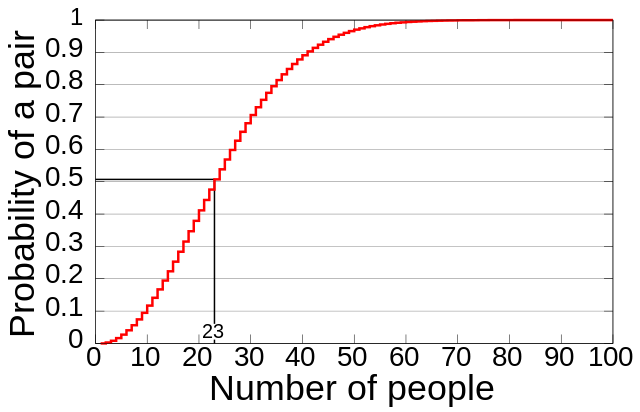The Birthday Problem
Let’s make a couple of assumptions. First, let’s assume that birthdays are randomly distributed — given enough people, you’ll have roughly the same number born on say, December 13th as you will on November 22nd or April 14th. (As it turns out, this isn’t true.) Second, let’s assume that February 29th — Leap Day — doesn’t exist. (Also untrue.) And, finally, let’s assume that everyone uses the 365-day Gregorian calendar. (Mostly true.) Got it? Nothing too controversial.
Say you walk into an empty auditorium. A minute or so later, someone else walks in. Again making the assumptions above, there’s a 1 in 365 chance (0.27%) that this person shares your birthday. A second person walks in a minute or two later. The odds of you sharing a birthday with either jumps to about 0.55%. A third and a fourth and — you get the idea. When the 253rd other person walks into that room — it’s been a few hours at that point! — only then do you have a 50% chance of having the same birthday as someone else in the room. It isn’t person 182 or 183 because some of the first two hundred-something may share birthdays. So the number 254 (including you) should make intuitive sense — or, at least, not be terribly shocking.
But let’s look at it a different way. Again, you start off in an empty auditorium and again, every few minutes, someone new comes into the room. But instead of wondering if you share a birthday with anyone else in the room, let’s make this about everyone in the room. Let’s ask: “Do any two people in the room share a birthday?” The math starts off the same — with two people, there’s still a 1 in 365 chance. The third person? The odds aren’t 0.55% anymore — now, there’s a 0.82% chance that anyone in the group matches someone else. Yes, you could share a birthday with either of the other two people — that’s the 0.55% — but they could share a birthday, too. That’s where the extra comes from.
How many people before we hit a 50% chance that any two share a birthday? 23. Not 230. Twenty-three. Here’s a graph, below, and in case you want to see the numbers, here’s a spreadsheet.

The odds go up very quickly because each new person can match every other person in the room, and as the number of people in the room grows, the gains are huge. At 57 people, there is just over a 99% chance of any two people in the room sharing a birthday. And, in case you are wondering, at 124 people, there is less than a 0.0000000001% chance of there not being a match. That’s one in one hundred trillion.
If that number doesn’t scare you, and you want to understand the math more, Wikipedia can help.
Bonus fact: Of course, birthdays aren’t random. Some months have more births than others, for reasons one can imagine (and you’d almost certainly be correct). Days of the week should be random — but, at least in the U.S, aren’t. Why not? As BabyCenter explains, Tuesdays and then Mondays have the highest number of births, because hospitals try not to schedule c-sections or induce labor on the weekends.
From the Archives: Happy Birthday (c): Why restaurants rarely sing the traditional happy birthday song. Or, February 30th. It existed, once.
Related: When math was simpler (and more colorful). 4.6 stars on over 100 reviews, although not as fun as this.
